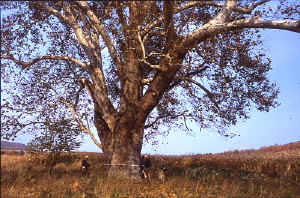ENTS,
On Sunday we visited the Pine Plains sycamore to begin the tree
modeling process. Monica positioned herself at the base of the
tree with
her paper and read and communed. Holly took digital images and
measured
the great tree’s stature. I fiddled with measuring equipment,
took some
preliminary measurements, and quickly came to the realization
that the
complicated Pine Plains sycamore is going to take at least 3
more
extended visits, and without a good sketch of the tree's
architecture to
identify what needs to be measured, what has been measured, and
what
needs to be re-measured, forget it. So, I switched gears and
made a
rough sketch of the trunk and big limbs and then resumed the
measuring
process. Later, Holly will make a more detailed, better scaled
drawing.
That assignment fits her well because she is an artist. BTW,
Holly lives
in historic Woodstock, NY, on the slope of the Catskills. Holly
has
plenty of relatives in Woodstock and she gave Monica and I a
semi-grand
tour on Sunday AM. It would have been a grand tour, but I was
fidgety
about getting to the Pine Plains sycamore. We got to the tree at
1:00PM,
so there was plenty of time, had I been better prepared.
 Pine Plains Sycamore, 2001
Pine Plains Sycamore, 2001
I'll relate as much information as I gleaned from the first
measuring
exercise.
Total height: 114.7'
(individual measurements range
from 114.0 to 115.2 ft)
Girth at ground level: 28.0'
Girth at 4.5 feet: 26.5'
Girth at 6.3 feet: 27.3'
(The monocular gave the equivalent of 26.7' at the point of
observation.
The huge tree is thicker at right angles to the above
measurement. This
will give rise to a second set of measurements at right angles
to the
first.)
Average crown spread: 141.1'
Maximum spread: 146.0'
The point of separation of the limbs from the trunk where the
limbs are
clearly separate comes at approximately 12 feet above the base.
At just
below 12 feet where there is solid wood throughout, the diameter
of the
Pine Plains tree is over 10 feet. Probably 11. There are 5 huge
limbs.
The following information covers the measurements taken, plus an
estimated one.
Limb# Girth Where
1 13.3
(at start)
2 11.0
(at start)
3 9.1
(at start. Limb broken off long ago. remainder about
5 feet)
4 12.9
(about 5 feet above the point with trunk separation.
Separation point not visible from vantage point)
5 Not
measured (at least 12.5 feet)
The limbs of this great tree repeatedly divide. At 19 feet,
above the
first major division, limb #1 is still 12.6 feet around. At 26
feet up,
above a minor division, limb #4 is 11.7 feet around. There is a
lot of
wood in the Pine Plains sycamore.
Just eye-balling the tree, my guess is that its total trunk-limb
volume
is between 2300 and 2800 cubic feet. I suppose it is possible
that the
total trunk-limb volume could go a little higher than the 2800,
but I
really don't think so from discussions with Will of what kinds
of
dimensions lead to 3000 cubes and more. My best guess at this
point is
2400 cubes for the Pine Plains sycamore. Regardless, the Pine
Plains
Sycamore is one of the great Northeastern trees. And there are
so many
twists and turns and limb divisions that it challenges us to
measure it.
We will have to parse this tree into many parts and work on it
limb at a
time.
I look very forward to developing an accurate model of the Pine
Plains
sycamore. Its rural setting is ideal. The road by the cornfield
in which
it sets is not busy. One does not have to contend with gawkers,
traffic
noises, etc.
A big challenge in modeling huge, spreading trees altogether
from the
ground is that one must shift back and forth among multiple
locations to
get full visibility of each object being measured. The best plan
is to
first sketch the tree, decide on where to take measurements, and
to
number the points on the drawing. Then one simply chooses a
target and
sticks with it until it has been satisfactorily measured. The
first
target might be the lower trunk. There after, a short section of
one
limb to a point of separation is a logical next step. Areas of
limb
division are always problematic because of the changes in
curvature and
the changes in cross sectional form. Often there is a veritable
explosion of limbs from a common point, with one or more limbs
partially
hidden.
With all the variables to contend with, initially, it is easy to
feel
overwhelmed with the sheer magnitude of the measuring challenge.
One is
inclined to try to do too much at one time. A point worth
emphasizing is
that modeling huge spreading hardwoods is truly a world apart
from
modeling compact, columnar pines and hemlocks. If regular
geometric
shapes characterize forest-grown pines and hemlocks, the lack
there of
characterize the big spreading hardwoods. So, volume modeling of
the big
hardwoods can never be the province of simple log-oriented
forest
mensuration techniques that treat the object to be measured as a
composite of simple forms that lend themselves to a quick
averaging
process. Therefore, the newly spawned ENTS applied branch of
science
that we'll call dendromorphometry is poles apart from forest
mensuration. One cannot be substituted for the other. One is not
a
subset or superset of the other.
Bob
Robert T. Leverett
Cofounder, Eastern Native Tree Society
|